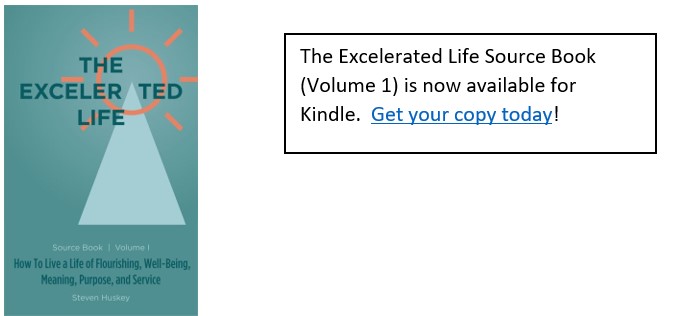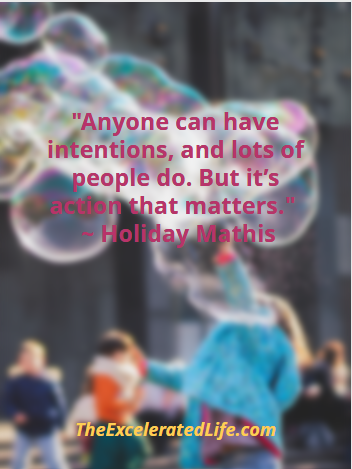There’s a difference between having a goal and reaching a goal and that difference is movement. If you aren’t taking actual steps to reach your goal, it’s still in the dream stage. You don’t have to figure everything out in the beginning. That isn’t always possible anyway. But find a way to begin – to go from having a goal to moving toward your goal.
Title Photo by Nataliya Vaitkevich
“If one advances confidently in the direction of his dreams, and endeavors to live the life which he has imagined, he will meet with a success unexpected in common hours.” ~ Henry David Thoreau
A Big Difference
I’m sure you’ve noticed this rather obvious insight: there is a difference between having a goal and reaching a goal. Here’s one story.
For a number of years, I had a goal to write a book. However, I’m afraid it wasn’t a real goal for a long time. It was more of a wish; a “someday I’m going to write a book” kind of thinking. I had no real plan and consequently made no real movement toward that particular goal. The difference between having that goal and reaching it was a huge chasm.
Last year, though, I realized I was tired of carrying that goal around and not doing anything to make real progress. So I decided it was time to get serious.
I knew that I hadn’t made much progress because I didn’t have a plan. And I didn’t have a plan because I didn’t know everything that I’d need to do to publish a book. But I remembered Jeff Olson’s statement that your plan won’t get you to the finish line . . . the plan is to get you started. I decided to just take a step and go from there.
First, I contacted some authors who had already published e-books. One was a friend but the others were people I didn’t know, a stretch in itself for me. All of them were very gracious in giving me feedback and suggestions. With a bit of research, I discovered that Amazon has a complete course on e-book publishing for Kindle.
I had a rough draft but I learned that it needed to be completely re-formatted for uploading to the Kindle publisher. At least that was a concrete step I could take to begin the actual publishing process. Finally, I had started and I began, at last, to move toward my goal.
The first tentative step led me to a second, more specific step, which led to the third step where I actually began working on publishing the book. I didn’t publish it last year which was my original plan because it took longer than I anticipated. But in late January of this year, I had everything ready and the book became available for download.
However, had I not decided to move from having a goal to reaching my goal by engaging in movement, that book would still be just a dream in my head.

What You Want And What You Get
I wonder if you have a similar story about some goals you’ve wanted. Have you seen in your own experience that having a goal is different than reaching a goal?
Do you have a goal now that you are not making any progress toward? You may have a BIG (Bold – Important – Gratifying) goal that could make a real difference in your life and the lives of your family but if you aren’t taking actual steps to reach your goal, it’s still in the dream stage.
The difference between having a goal and reaching a goal is movement.
Why We Need Movement
“Anyone can have intentions, and lots of people do. But it’s action that matters.” ~ Holiday Mathis
I think that, for whatever reasons, a lot of us fall into this trap. Unfortunately, many people I know don’t have any goals, at least not specific, measurable things they want to be, do or have. And if you don’t have a goal, there is nothing that can help you start moving toward it. So actually having goals is the first step. In fact, I’d call that Step 0.
Most of us weren’t taught about goals as children. Not by parents, teachers, or any other adults in our lives. If you participated in a sport, perhaps you were told about having goals related to your sport or your team, but I doubt many of us received specific instructions for goal setting. At least that was my experience.
Those of us who did eventually discover the significance of having goals likely didn’t learn the importance of taking the necessary actions to move toward our goals. We didn’t learn that there is a difference between having a goal and reaching a goal.
And now that we do know, how can we put that insight to use?
Excelerated Movement™
“Thinking counts as effort, but nothing comes into being through thought alone. Air must be moved, words spoken, written, or sung, action and work of any kind completed. The more air that is moved, the more real a thing becomes.” ~ Holiday Mathis
Here are some suggestions to help you figure out what you need to do to move toward your goal. Keep in mind that you don’t have to figure everything out in the beginning. In fact, that often is not possible. Just find a way to begin – to go from having a goal to moving toward your goal.
Remember, not all movement takes you in the right direction. For example, I spent months formatting my book only to discover that it didn’t meet the requirements for Kindle Publisher. I was moving, but you might say in the wrong direction.
However, that movement got me started, got me going. Even though I ended up doing it over, if I hadn’t started, I wouldn’t have even gotten that far. You may meet detours yourself on the way to reaching your goal but they are detours, NOT dead ends. As Cathy Stucker says, “it is better to do the wrong thing than nothing. Any action you take will lead you closer to your goal.”
Focus on one goal at a time. “One goal at a time – that’s important. That’s where most people unwittingly make their mistake. They don’t concentrate on a single goal long enough to reach it before they’re off on another track, then another, with the result that they achieve nothing – nothing but confusion – and making excuses.” [Nightingale]
Have only one primary goal, or at most one professional and one personal goal. More than one dilutes your movement. Plus multiple goals could conflict with one another and have you moving in different directions.
As you begin moving toward your goal, take tiny steps. That’s the quickest and easiest way to turn the behavior into a habit. Let’s look quickly at BJ Fogg’s Behavior Model. This model shows us that Behavior is a function of Motivation, Ability, and a Prompt (B = MAP).
Without a prompt, nothing happens. Motivation and ability go hand-in-hand. The higher your motivation, the more likely you are to do the behavior BUT the harder the behavior is to do, the less likely you are to do it. That’s why we always focus on tiny steps.
Tiny steps get us past the motivation/ability hump. They are so easy to do, “stupid small” in the words of Stephen Guise, that you need very little motivation (although you do need that little bit).
A Movement Example
Consider this example. Let’s say you want to begin a habit of daily reading. Here are the tiny steps to get you started.
- Print the 66 Days habit tracker. This elementary tracker is based on research that indicates the average time to make a behavior automatic is 66 days. Although it can in actuality take anywhere from 18 to 254 days, let’s start with sixty-six. The 66 Days tracker has 5 groups of 66 days, so you can always start another round of 66 if you’re feeling it. Post the page somewhere you’ll see it regularly.
- Do the “starter step”. [Fogg] Sit down and open the book. You may want to select a specific time of day, such as after dinner before turning on the TV, or first thing when you get up in the morning. This is just to make it easier to remember to do the step when you’re first starting.
- That’s it! You may read a page, a paragraph, 10 pages, or 1 sentence – but you get credit if you sit down and open the book (or e-reader).
- Now, and this is important, celebrate! This Tiny Habit Workbook gives you some ideas for celebrating. And as part of your celebration, check a day off on your 66-Day tracker.

Here are some suggestions for starter steps for other behaviors. If you want to do a workout, do 1 pushup (from Stephen Guise’s Mini Habits). Or if you want to start a walking or jogging routine, put on your running shoes. If you want to start flossing every night, floss one tooth (from BJ Fogg’s Tiny Habits).
Now, take a behavior that leads to your goal, which you want to make a habit of doing, and figure out a way to scale it way, way down into a tiny starter step. And remember to always add a celebration and to check each day (either on the 66-Day tracker or your calendar) you do the behavior.
Of course, you won’t do this starter step forever but your aim here is to make the behavior automatic. Once you’re used to sitting down and opening the book, you can upgrade your step to reading one paragraph, then one page, then ten pages. But each bigger step must be done only after you’re effortlessly doing the current amount. And you still get credit if you need to go back to your first starter step on any day. Consistency is key, that’s why you make it small enough to easily do and why you keep track of how many days you’ve done it.
You Have To Have A Goal
Naturally, to achieve a goal, you have to have a goal. Remember, that’s our Step 0. If you don’t have a BIG (Bold – Important – Gratifying) goal yet, here are a couple of resources to get you started.
The Goal Achievement Excelerator is an in-depth goal-setting tool that consists of 9 steps with corresponding worksheets. The nine steps lead you from brainstorming possible goals to prioritizing your choices, then stating your selected goal as a SMART+Plus goal. You tap into your own personal problem-solving techniques to develop a general goal strategy. Then you create specific action steps to implement your strategy. You consider obstacles you may encounter on the path to your goal and develop specific actions to deal with them. Finally, you put it all into a Goals Work Sheet – your individual personalized goal plan ready to help you take off.
If you already have a BIG goal but you aren’t making any progress, try the Excelerator JumpStart – Goal Setting. The JumpStart tool provides quick actions you can take right now to jumpstart your Excelerated Life™ and begin planning and achieving BIG goals.
The First Ingredient
As you begin taking the tiny steps that make the difference between having a goal and reaching your goal, keep in mind Jeff Olson’s “first ingredient”. [Olsen]
At some time or other, someone may have said to you, or you may have told yourself that “you have to want it bad enough” or “you have to try really, really hard”. You may be laboring under these assumptions, or they may have hindered your attempts in the past. However, these bits of “advice” don’t work.
So before starting your goal journey, find your “missing first ingredient” — your philosophy, how you think about the simple things, i.e., the small steps that lead to your goal. If you think you have to have the finished plan with all of the exact steps you’ll need to take to reach your goal before you ever start, reexamine your philosophy. If you think you must take huge “giant steps” in order to achieve your goal, think again. This is the important “first ingredient”. Your philosophy shapes your attitude, your actions, and your results. And these create your life.
Ideas To Help You Get Moving
Once you have your BIG goal and your starter step in mind, you’re ready to move toward your goal. It won’t happen overnight if it’s a sufficiently BIG goal. But once you start – and stick with it – you’ll advance confidently in the direction of your dreams, to paraphrase Henry David Thoreau, and you’ll “meet with a success unexpected in common hours.”
To help you start advancing confidently in the direction of your dreams, check out the Excelerator JumpStart – Movement. This tool JumpStarts your ability and your resolve to take action in pursuit of your BIG goals. These are steps you can take right now to begin acting on your goal, task, or objective.
Move Toward Your Goal
Remember, if you aren’t taking actual steps to reach your goal, it’s still in the dream stage. There’s a difference between having a goal and reaching a goal and that difference is movement.
Start with the “first ingredient” – your philosophy which shapes your attitude, illuminates your actions, and gives you your results. Then, focus on one goal at a time. Do the “starter step”. And don’t forget to celebrate each time you take that step.
Keep in mind that you don’t have to figure everything out in the beginning. That isn’t always possible anyway. Just find a way to begin – to go from having a goal to moving toward your goal. That is embracing your Excelerated Life™!
Do you have a goal or a dream you want to make progress on?
What steps could you take to begin moving toward your goal today?
Share your thoughts by leaving a comment below.
Excelerated Movement™ — taking right action in pursuit of your goals — is one step in creating your Excelerated Life™, a life of flourishing and well-being, and a life of meaning, purpose, and service.
Read more about the Excelerated Life™.
Resources:
Fogg, Ph.D., BJ. Tiny Habits: The Small Changes That Change Everything. New York: Houghton Mifflin Harcourt Publishing Company, 2020.
Guise, Stephen. Mini Habits: Smaller Habits, Bigger Results. CreateSpace Publishing. 2013.
Nightingale, Earl. “Lead The Field.” PDFDrive. Asaha Inc., . Web. Date July 17, 2020. PDF file.
https://www.pdfdrive.com/lead-the-field-e186040772.html
Olson, Jeff. The Slight Edge. Austin, TX: Greenleaf Book Group Press, 2005-2013.


